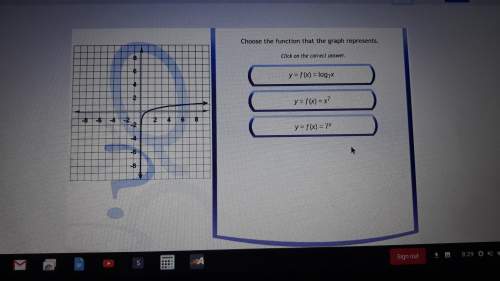
Mathematics, 21.12.2020 17:10 2002kaitlynmull
Ankur estimated the quotient of 15 and one-third divided by (negative 4 and two-thirds) to be 3. Which best describes his error?
Ankur multiplied the compatible numbers 15 and –3.
Ankur found that the quotient of a positive number and a negative number is negative.
Ankur found that the quotient of a positive number and a negative number is positive.
Ankur added the compatible numbers 15 and –3.

Answers: 1


Other questions on the subject: Mathematics

Mathematics, 21.06.2019 17:00, 19youngr
You are on a cycling trip around europe with friends. you check the weather forecast for the first week. these are the temperatures for the week. sun mon tues wed thurs fri sat 16°c 20°c 24°c 28°c 28°c 23°c 15°c what is the mean temperature forecast for the week?
Answers: 1

Mathematics, 21.06.2019 20:00, anabelleacunamu
Find the value of x. round the length to the nearest tenth
Answers: 1

Mathematics, 22.06.2019 02:00, darianhaynes
Study published in the journal of personality and individual differences found that adults with adhd displayed more creative achievement than those who didn't have the disorder. "for the same reason that adhd might create problems, like distraction, it can also allow an openness to new ideas," says holly white, assistant professor of cognitive psychology. "not being completely focused on a task lets the mind make associations that might not have happened otherwise." white and priti shah at the university of michigan gave 60 college students – half of them with adhd – a series of tests measuring creativity across 10 domains. the adhd group scored higher across the board. the adhd group showed more of a preference for brainstorming and generating ideas than the non-adhd group, which preferred refining and clarifying ideas. the adhd status of the participants was established by asking whether the individual had ever been clinically diagnosed with adhd/add. the tests of creativity were pencil-and-paper tasks administered in a laboratory setting. each of the ten scales was comprised of multiple questions, the scores on which were summed (e. g., writing creativity: "how many words can you make from the letters in the word 'psychology' invention creativity: "write down as many uses for a paper clip that you can think of.") this procedure does allow for a participant to be scored as showing no creativity under these conditions. a) state the research question in plain language (i wonder if is related to (1 point) b) state the null hypothesis (1 point) c) state the research hypothesis (1 point) d) is the research hypothesis directional or non-directional (1 point) e) name the predictor / independent variable f) give the operational definition of the predictor / independent variable g) evaluate the construct validity of the predictor / independent variable. (face, procedure, method-match) h) name the outcome / dependent variable i) give the operational definition of the outcome / dependent variable. j) evaluate the construct validity of the outcome / dependent variable. (face, procedure, method-match)
Answers: 1

Mathematics, 22.06.2019 03:30, ericperkins10ox0b27
Consider the diagram. lines e and c can be described as
Answers: 3
You know the right answer?
Ankur estimated the quotient of 15 and one-third divided by (negative 4 and two-thirds) to be 3. Whi...
Questions in other subjects:




Social Studies, 29.10.2019 23:31


English, 29.10.2019 23:31

Health, 29.10.2019 23:31

Biology, 29.10.2019 23:31





